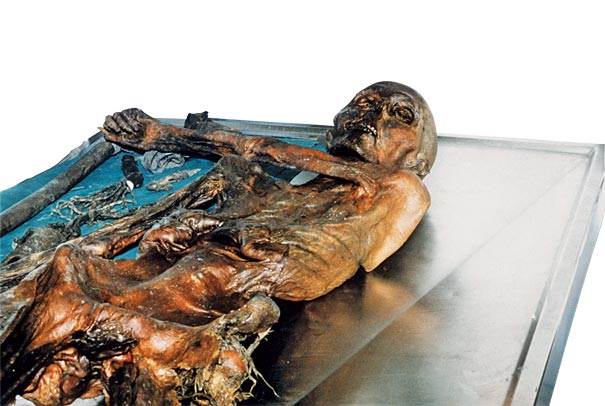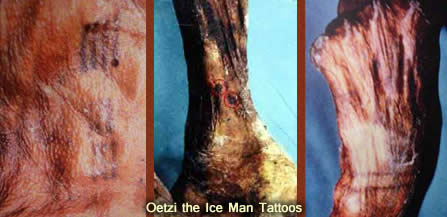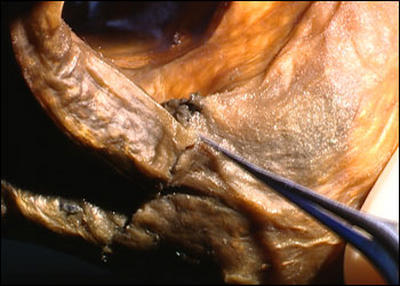
Claims of a Tutankhamen-style curse have begun to spread about Oetzi. Indeed, seven strange deaths occurred just a couple of years after German hiker Helmut Simon and his wife Erika discovered the frozen mummy in the Oetztal Alps in 1991. The seven people who died were all involved either in the recovery of the mummy or in the scientific investigation. One of the seven was Helmut Simon, whose body was found trapped in ice in 2004, just like his famous find

The Ice Mummy: Little-Known Facts
Ötzi the Iceman has at least 19 living male relatives in the Austrian Tirol, according to a genetic study into the origins of the people who now inhabit the region.

Exactly 20 years ago, on Sept. 19, 1991, German hikers Erika and Helmut Simon spotted something brown while walking near a melting glacier in the Oetztal Alps in South Tyrol. As they got closer, they realized with horror it wasn't a piece of rubbish, but a human corpse lying on its chest against a flat rock

Only the back of the head, the bare shoulders and part of the back emerged from the ice and meltwater.
NEWS: Iceman May Have Received Formal Burial
Scientists from the Institute of Legal Medicine at Innsbruck Medical University analyzed DNA samples taken from 3,700 blood donors in the Tyrol region of Austria.

In the following days, various attempts at recovering the corpse were made. Finally, on Sept. 23, the body was extracted from the ice along with numerous pieces of leather and hide, string, straps and clumps of hay. The mummified body was taken to the Institute of Forensic Medicine in Innsbruck
During their study, they discovered that 19 individuals share a particular genetic mutation with the 5,300-year-old mummy, whose full genome was published last year.

The mummy lay in a 131-foot-long, 9-foot -deep and 22- foot -wide rocky gully surrounded by steep stone walls at an altitude of 10.531 feet. Since the glacier made it difficult to establish the exact location of the watershed, a controversy arose on which soil -- Italian or Austrian -- it was found. A survey of the border carried out on Oct. 2, 1991 established that the mummy lay 303.67 feet from the border in South Tyrol, in Italy

The discovery caused a global media sensation. Initially, the mummy was dated to be at least 4,000 years old (later, radio carbon dating established that the man lived around 5,000 years ago, between 3350 and 3100 B.C.). Such an old, well preserved, fully clothed, mummified body had never before been seen
“These men and the Iceman had the same ancestors,” Walther Parson, the forensic scientist who carried out the study, told the Austrian Press Agency.
The researchers focused on parts of the human DNA which are generally inherited unchanged.

Between July 20 and Aug. 25, 1992, a second archaeological survey was carried out at the glacier. Numerous pieces of the Iceman's equipment emerged, such as a bearskin cap, leather and hide remnants, grasses, string, pieces of skin, muscle fibers, hair and a fingernail
“In men it is the Y chromosomes and in females the mitochondria. Eventual changes arise due to mutations, which are then inherited further,” Parson explained.
People with the same mutations are categorized in haplogroups. Designed with letters, haplogroups allow researchers to trace early migratory routes since they are often associated with defined populations and geographical regions.

Although the most important piece in the Iceman's equipment is a copper-bladed axe (tests have shown it could have chopped down a yew tree in 35 minutes) this stone disc is the most mysterious. Made of white Dolomite marble, it has a hole in the middle through which a hide strip was threaded. Nine twisted hide thongs were tied on to a loop in this strip. After 20 years, the disc's function remains unclear
Indeed, Ötzi’s haplogroup is very rare in Europe.
“The Iceman had the halogroup G, sub category G-L91. In our research we found another 19 people with this genetic group and subgroup,” Parson said.

Oetzi is the world's most studied mummy. The Neolithic man is a so-called "wet mummy." As humidity is retained in individual cells, the body tissue is elastic and allows in-depth scientific investigations. With all his recovered clothing and equipment, this natural mummy, unaltered by burial rites, provides a unique view into Stone Age life in Europe
Having carried Y chromosome haplogroup analysis, Parson was able to trace only the male descendants of the Neolithic man.
So far the 19 individuals have not been informed of their genetic relationship to Ötzi.

Researchers were able to diagnose several anatomic anomalies and pathologies in the mummy: Oetzi lacked a 12th pair of ribs, had bad teeth, worn joints and hardened arteries, and suffered from whipworm infestation. He also had a remarkable diastema -- a natural gap between his two upper incisors
Found in 1991 in a melting glacier in the Ötztal Alps (hence the name), the mummy is one of the most heavily investigated human corpses of all time.

Scientists discovered that Ötzi had brown eyes and very bad teeth, was lactose intolerant, had a genetic predisposition for an increased risk for coronary heart disease and probably had Lyme disease.

Oetzi's body is covered with over 50 tattoos produced by fine incisions into which charcoal was rubbed. The cuts were probably part of a pain-relieving treatment. Indeed, the tattooed areas correspond to skin acupuncture lines. Before Oetzi, it was believed that acupuncture originated 2,000 years later in Asia

It’s certain he died a violent death: In 2007, CT scans showed that an arrowhead had lacerated his left subclavian artery, leading to fast bleeding.

In 2001 new X-ray analysis revealed the presence of a flint arrowhead in the left shoulder. The arrowhead ended up just a few inches from the lung. Although vital organs were not hit, the arrow severed a major blood vessel and damaged the neurovascular fascicles of the left arm. This caused heavy bleeding and possibly paralysis of the arm. The Iceman probably bled to death within a matter of minutes. A deep wound to the hand and numerous bruises confirm that the Iceman engaged in hand-to-hand combat shortly before his death. Recently, researchers also discovered a skull fracture and major bleeding in the back, suggesting that the mummy also suffered a blow to the head. He died in the spring or early summer at about age 45
CAT scan of the mummy’s brain and a paleoproteomic study have recently pointed to a cerebral trauma — a violent blow to the head — as the cause of death.
As investigation into the mummy continues, new relatives, alive and well, could be added to the list of the 19 descendants.

This reconstruction by two Dutch experts, Alfons and Adrie Kennis, was produced with the latest in forensic mapping technology. It used three-dimensional images of the mummy's skull as well as infrared and tomographic images. It shows Oetzi as a brown-eyed, bearded, furrow faced man who spent many hours walking in the mountains. He was about 5 foot, 3 inches tall and weighed 110 pounds. The Iceman belonged to a European genetic group and was probably infertile

According to Parson, the genetic mutation might be also found in the nearby Swiss region of Engadine and in Italy’s South Tyrol region.

On Jan. 16, 1998, the Iceman and his belongings were moved from the Institute for Anatomy of Innsbruck University to a newly-built South Tyrol Museum of Archaeology in Bolzano. The mummy now lies in a darkened room and can be viewed through a small window. At a temperature of -42F° and a relative humidity of 98 percent, Oetzi's house simulates the conditions of the glacier ice. To stop the mummy from gradually drying out, the cell walls are lined with tiles of ice
“We have already found Swiss and Italian partners so that we can continue our research,” he said.

Ötzi the Iceman in his new cell at the South Tyrol Museum of Archaeology in Bolzano
Exactly 20 years ago, on Sept. 19, 1991, German hikers Erika and Helmut Simon spotted something brown while walking near a melting glacier in the Ötztal Alps in South Tyrol.
As they got closer, they realized with horror that it wasn't just some sort of rubbish: a human corpse was lying with the chest against a flat rock.
Only the back of the head, the bare shoulders and part of the back emerged from the ice and meltwater.

The hikers thought the body belonged to an unfortunate victim of a mountaineering accident a few years back. In fact, they discovered one of the world's oldest and best preserved mummies.
To commemorate the 20th anniversary of this sensational discovery, here are 20 known and lesser known facts about the Neothiltic frozen mummy.
1. An incredible chain of coincidences allowed the Iceman to remain intact: he was covered by snow shortly after his death and later by ice; the deep gully where the Iceman lay prevented the body from being ground up by the base of the glacier; the body was exposed to damaging sunlight and wind only for a short time in 1991 between the time the mummy thawed and the accidental discovery.
2. It was an Austrian reporter, Karl Wendl, who first named the mummy "Ötzi," referring to the Ötzal Alps where it was found. According to a resolution by the South Tyrol Provincial Government, the official name for the mummy is "Der Mann aus dem Eis" — "L'Uomo venuto dal ghiaccio" (The man who came from ice).

3. Soon after the mummy was recovered, a harsh controversy arose on which soil — Italian or Austrian — it was found. A survey of the border carried out on Oct. 2, 1991 established that the mummy lay 303.67 feet from the border in South Tyrol, in Italy.
4. Radio carbon dating established that the Ötzi lived around 5,000 years ago, between 3350 and 3100 B.C.
5. Recent investigations established that he had brown eyes, not blue as previously thought.
6. Ötzi was probably a bearded, furrow faced man. He was about 5 foot, 3 inches tall and weighed 110 pounds.
7. He lacked a twelfth pair of ribs — a rare anatomical anomaly.
8. The Iceman had a remarkable diastema, or natural gap, between his two upper incisors. He also lacked wisdom teeth. Even though he suffered from cavities, worn teeth and periodontal diseases, he still had all his teeth when he died at around 45.
9. Ötzi could have been a little better endowed. The man's natural mummification and dehydration in the Alpine glacier produced a "collapse of the genitalia," which left the Iceman with an almost invisible member.
10. The Iceman's last meal probably consisted of a porridge of einkorn, meat and vegetables. Researchers are still investigating the sampled material to determine the exact nature on the Iceman’s last meal.
11. Three gallbladder stones were recently found which, in combination with the previously identified atherosclerosis, show that Ötzi’s diet may have been richer in animal products than previously thought.

12. The Iceman's stomach also contained 30 different types of pollen, which ended up there with the food he ate, the water he drank and the air he breathed. The pollen showed that he died in the spring or early summer.
13. Analysis of the isotopic composition of Ötzi's tooth enamel and bones suggest that the man was born and lived in what is now South Tyrol. He probably spent his childhood in the upper Eisack Valley or the lower Puster Valley. He lived at least ten years in the Vinschgau prior to his death.

14. Among the clothing and items found with the mummy, one of the most important pieces is the copper-bladed axe. Archaeological experiments showed that the axe could fell a yew tree in 35 minutes without sharpening.

15. Ötzi's body is covered with over 50 tattoos made with fine incisions into which charcoal was rubbed. In the shape of lines and crosses, they were probably used as pain-relieving treatments. Indeed, the tattooed areas correspond to skin acupuncture lines, which predate acupunture in Asia by two thousand years.
16. Many theories have been proposed on Ötzi' social status. Among the various theories, the Iceman was identified with a shaman, a mineral prospector looking for ore deposits in the mountains, a hunter, a trader, a shepherd, and a man banished from his community.
17. The Iceman had been involved in a fight shortly before his death. He was shot with an arrow which pierced the subclavian artery and also suffered a violent blow to the head just before dying.

18. Ötzi's belonged to the European genetic haplogroup K. He was probably infertile.

19. Ötzi's constitution was athletic. He was more a wanderer than a manual worker. Recent research by Albert Zink at the EURAC Institute for Mummies and the Iceman in Bolzano, found signs of enthesopathy (an inflammatory disease of bone attachments) in the knees, which indicate that the Neolithic man spent many hours wandering in the mountains.

20. Claims of a Tutankhamen-style curse refer to seven strange deaths which occurred just a couple of years after German hiker Helmut Simon and his wife Erika discovered the frozen mummy. The seven dead people were either involved in the recovery of the mummy or in the scientific investigation. One of them was Helmut Simon, whose body was found trapped in ice in 2004, just like his famous find.

In reality, hundreds of individuals have worked on the Iceman project. Although sad, it's not so peculiar that some of those people have died since the mummy's discovery.

An injury to the head, not an arrow wound, may have killed Ötzi the Iceman, the 5,300-year-old mummy found in the Italian Alps, says a new paleoproteomic study into the brain of Europe’s oldest natural human mummy.

The protein investigation appears to support a 2007 research into the mummy’s brain. The study pointed to a cerebral trauma as the cause of death.

At that time, the research relied on a CAT scan of the mummy’s brain, which showed two dark-colored areas at the back of the cerebrum. The injury added to the already known arrowhead wound on the shoulder and wounds on the hand.

Found in Ötzi’s left shoulder in 2001, the stone arrowhead has long been thought to have caused the prehistoric man’s death, fatally severing his left subclavian artery.

The 2007 study suggested that blood loss from the arrow wound would have first made Ötzi lose consciousness, with death coming later, from a violent blow to the head.

Either the man’s killer gave Ötzi the final whack, possibly by hitting him with a stone, or he could have fallen over backwards and hit his head on a rock, the researchers concluded.

The hypothesis had been left unexplored until 2010, when a research team from the European Academy of Bolzano/Bozen (EURAC), Saarland University, Kiel University and other partners decided to investigate the proteome of two pinhead-sized samples of brain tissue from the world-famous glacier corpse.

“The use of new protein-analysis methods has enabled us to pioneer this type of protein investigation on the soft tissue of a mummified human, extracting from the tiniest sample a vast quantity of data which in the future may well answer many further questions,” the researchers said.
Indeed, the scientists were able to identify a total of 502 different proteins.
“Of these, 41 proteins are known to be highly abundant in brain tissue and nine are even specifically expressed in the brain,” microbiologists Frank Maixner of EURAC, Andreas Tholey of Kiel University, and colleagues wrote in the journal Cellular and Molecular Life Sciences.
“Furthermore, we found 10 proteins related to blood and coagulation. An enrichment analysis revealed a significant accumulation of proteins related to stress response and wound healing,” they wrote.
Found in a corpse almost devoid of blood, the astonishingly well-preserved clotted blood cells provide further evidence that Ötzi’s brain had possibly suffered bruising shortly before his death.

Whether this was due to a blow to the forehead or a fall after being injured by the arrow remains unclear.

“Our data reopens former discussions about a possible injury of the Iceman’s head near the site where the tissue samples have been extracted,” the researchers said.

Since his discovery in 1991 in a melting glacier in the Ötztal Alps — hence his name — the mummy has been extensively investigated.

Scientists discovered that Ötzi had brown eyes, was lactose intolerant, had a genetic predisposition for an increased risk for coronary heart disease, and probably had Lyme disease.

The Shoes | Ötzi
The new protein-based research method could now provide insights that previously had not been possible, the researchers said.
VIDEOS
In Focus: Ötzi "The Ice Man"
Ötzi Iceman Murder Mystery (full) HD
Documentary presenting new theories on Ötzi the Iceman, one of the oldest and best preserved human remains found to date. Experts conduct new tests on Ötzis 5,300 year old mummified body. They speculate on how he is likely to have met his demise

No comments:
Post a Comment
Note: Only a member of this blog may post a comment.